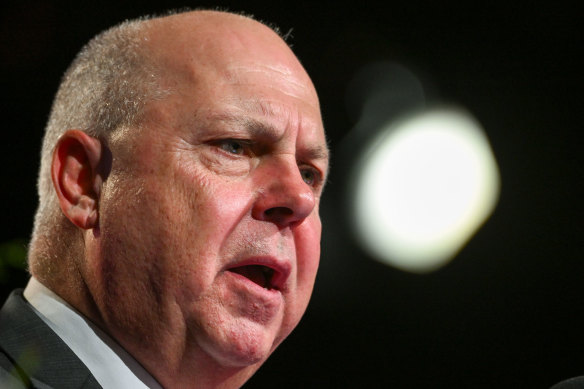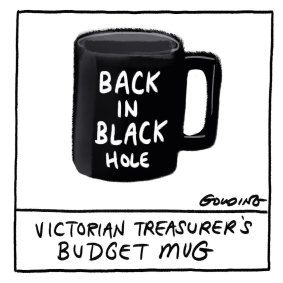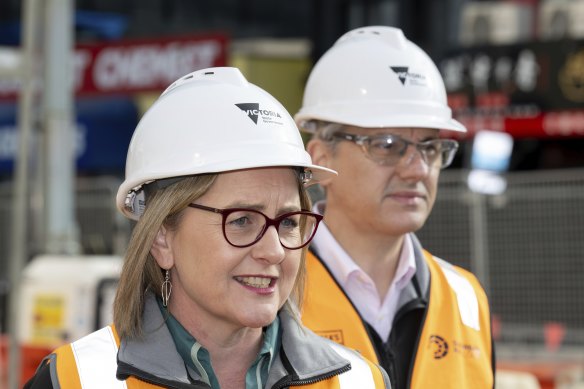- Exclusive
- Politics
- Victoria
- Victorian budget
The multibillion-dollar blow primed to hit Victorian taxpayers and the budget
Victorian government agencies are expected to pay out $15 billion a year for insurance claims by 2028, a 36 per cent increase that could wreak havoc on the state’s finances and leave taxpayers facing huge top-up payments to keep the organisations solvent.
Department of Treasury and Finance documents, updated as part of the state budget, have forecast a surge in the amount paid out by bodies such as the Transport Accident Commission, WorkCover and the Victorian Managed Insurance Agency.

Victorian Treasurer Tim Pallas. Credit: Eddie Jim
Since 2020, the state government has had to pay $1.3 billion out of its budget to prop up its workers’ compensation scheme. It said WorkCover was “fundamentally broken” in 2023.
The Victorian Managed Insurance Agency has increased charges on home builders twice in a year – by 43 per cent and 65 per cent – blaming multiple large business insolvencies and the rising costs of construction.
Treasurer Tim Pallas’ state budget is already under significant strain. Ballooning net debt, racked up during the pandemic, is forecast to reach $187.8 billion by the middle of 2028. The annual interest bill for this debt is expected to be $9.4 billion by this time.

Credit: Matt Golding
Efforts to rein in spending on hospitals and major projects have since created political headaches for the government. The latest Resolve Political Monitor put Labor’s primary vote at 27 per cent – the lowest in three years.
The department’s forecasts predict even more pain on the horizon for the agencies known as public financial corporations. These agencies are meant to fund themselves, but taxpayers have topped them up when they have fallen short.
The forecasts show that in the 2023-24 financial year, it was expected the agencies would pay out a total of $9.9 billion in claims – but the final cost blew out to $11 billion.
Costs are expected to keep rising. By 2028, the total amount spent each year will rise to $15 billion – an increase of 36 per cent.
In the 2017-18 financial year, this expense was $6.027 billion.
An Allan government spokesperson said the increased insurance costs primarily came from increases in WorkCover claims, which they said had tripled since 2010.
“[This was] mainly driven by the increased cost of weekly income support and many workers staying on the scheme for extended and indefinite periods of time,” the spokesperson said.

Victorian Premier Jacinta Allan with WorkSafe Minister Danny Pearson.Credit: Penny Stephens
“We passed legislation in March to ensure WorkCover remains financially sustainable and can continue to support injured workers well into the future.
“Alongside reforms to modernise WorkCover, we’ve established Return to Work Victoria to ensure injured workers have the best support to return to work safely and as soon as possible because we know the longer a person spends away from work, the less likely it is that they will return.”
WorkCover premiums rose by an average of 42 per cent last year, prompting the state government to push through legislation limiting access to some mental health claims such as for stress and burnout.
The state government will hold an independent review of WorkSafe by the end of the year to check whether these changes are working and whether the WorkCover compensation scheme is sustainable.
AMP chief economist Dr Shane Oliver said Victorian government agencies were feeling the same pressures as the private sector, leaving them with the option of either raising premiums, reducing eligibility for claims or being topped up through budget funds.
He said natural disasters and other unforeseen events had led to increases in claims just as inflation was making it difficult for authorities to respond to them.
“If something is damaged, it’s costing more to either replace or rebuild it,” Oliver said. “When the value of claims goes up, you run down your reserves.”
Oliver said governments couldn’t prevent weather events but could attack the problem by reining in inflation across the economy.
Opposition finance spokeswoman Jess Wilson said Victoria’s public insurers were being mismanaged and becoming a “significant drag” on the state’s broader financial position.
“Under Labor, Victoria’s public insurers have been run into the ground, and if these agencies were operating in the private sector, they would have gone out of business long ago,” she said.
“The continued multibillion-dollar losses year-on-year in this sector are simply unsustainable, and whether through higher premiums, poorer services or taxpayer-funded bailouts, Victorians ultimately pay the price.”
A spokesperson for the Insurance Council of Australia said it was a “hard market” globally, making it difficult to obtain reinsurance or take on additional risks and pushing up the price and availability of coverage.
“According to the Australian Prudential Regulation Authority, there has been a 5.5 per cent average annual increase in bodily injury claims since 2013, which, along with rising costs associated with lawsuits and medical care for injuries, fuel claims cost,” the spokesperson said.
“Furthermore, according to Safe Work Australia, there are trends indicative of an increasing level of psychological injuries in workers’ compensation claims in recent years.”
When the Victorian Managed Insurance Agency increased premiums for domestic building insurance in June, the Housing Industry Association estimated the premium paid on a single home build with a contract value of $500,000 would rise from $3872 to almost $6400.
Since July 1, 2023, the authority has resolved more than 4000 domestic building claims, largely driven by the collapse of Porter Davis and other smaller insolvencies that hit the industry during that time.
Vehicle registration fees rose by between $20 and $24.10 on July 1, partly spurred by increases to the Transport Accident Charge used to fund treatment and support for people injured in road accidents.
Get the day’s breaking news, entertainment ideas and a long read to enjoy. Sign up to receive our Evening Edition newsletter here.